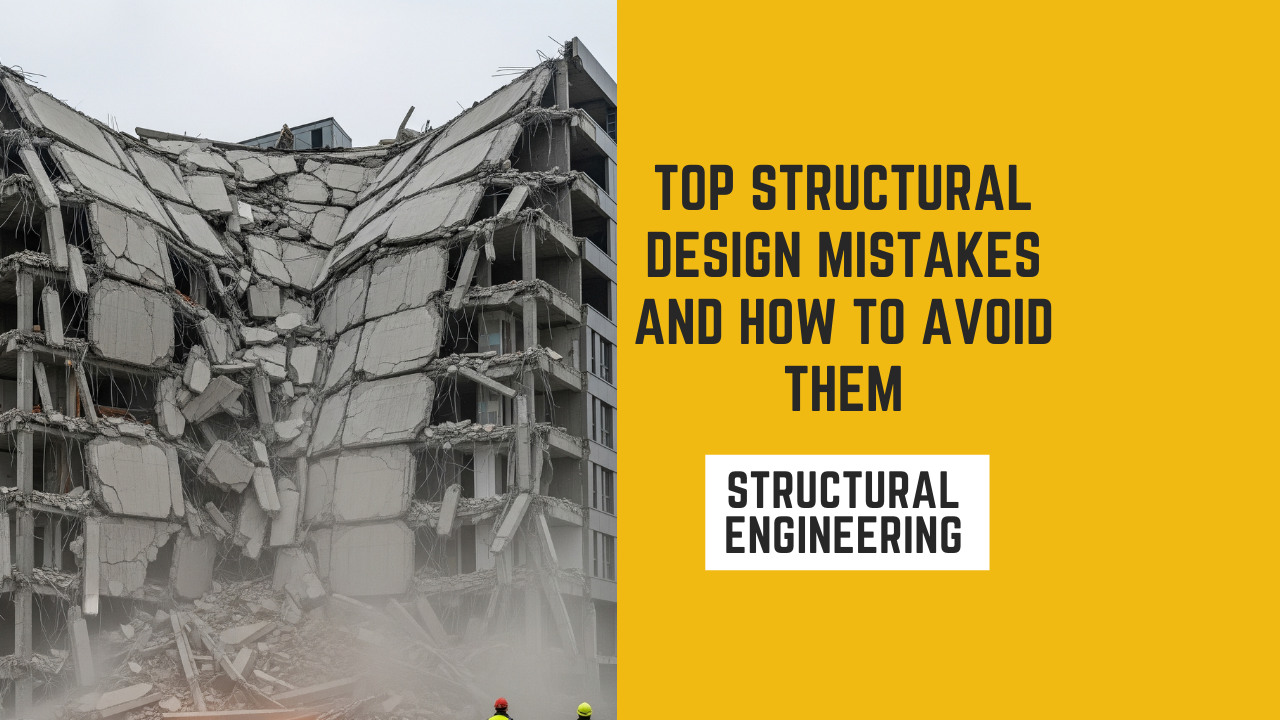Top Structural Design Mistakes and How to Avoid Them

Introduction
Structural design is one of the most critical aspects of construction. A single mistake in the design process can result in major failures, legal liability, or even structural collapse. these mistakes are often caused by poor calculations, misuse of software, or lack of coordination
In this article, we’ll explore the top structural design mistakes engineers commonly make and how you can avoid them with practical solutions and updated tools.
1. Inadequate Load Calculations
Many structures fail due to improper estimation of loads. These include dead loads, live loads, wind, seismic, and impact forces
Common Errors
- Underestimating live loads or snow loads
- Misapplying load combinations
- Ignoring localized wind or seismic effects
Solution
- Fallow national or international codes (e.g., ASCE, Eurocode, IS 875)
- Use software that supports auto-calculation of loads and code-based design
- Verify results manually in critical elements
2. Ignoring Soil and Foundation Conditions
Structural design must start with a proper understanding of ground conditions. Failing to do so can lead to settlement, tilting or collapse
Common Errors
- Assuming uniform soil without testing
- Using incorrect bearing capacity
- Choosing wrong foundation type
Solution
- Always require a geotechnical report
- Match foundation type to soil conditions (e.g., raft, pile)
- Apply adequate safety factors
3. Misuse of Structural Design Software
Structural analysis software like ETABS, STAAD, and SAFE are powerful tools, but when misused, they lead to incorrect designs.
Common Errors
- Wrong input data or units
- Missing restraints or boundary conditions
- Blind trust in software output
Solution
- Get formal training in software.
- Double-check software input and output manually
- Use built-in code checkers where available
4. Incorrect Load Path Understanding
The load path must be clear from the roof down to the foundation. Disruptions in the path can create weak points in the structure.
Common Errors
- Discontinuous columns or beams
- Lack of lateral support
- Ignoring transfer of loads during floor plan changes
Solution
- Trace the load path during concept stage
- Include redundancy in structural elements
- Coordinate with the architect to preserve structure integrity
5. Poor Detailing and Construction Tolerances
Good structural design is useless without proper detailing. Overlapping bars, poor anchorage, or congested reinforcement often cause field problems
Common Errors
- Reinforcement clashes at joints
- Vague drawings without dimensions
- Ignoring site feasibility
Solution
- Fallow cod-specific detailing manually
- Use 3D reinforcement modeling in BIM tools
- Perform construct-ability review during design phase
6. Neglecting wind and Seismic Design
In high-risk areas, wind and earthquake forces can dominate design. These should never be neglected
Common Errors
- No shear walls or lateral systems
- Unbalanced floor plans
- Underestimating base shear and torsion
Solution
- Perform lateral force analysis in seismic zones
- Use ductile detailing techniques
- Incorporate bracing or shear walls for lateral resistance
7. Unsafe or Arbitrary Safety Factors
Overuse or underuse of safety factors can compromise both economy and safety.
Common Errors
- Applying double safety margins unnecessarily
- Not updating safety factors to new code standards
Solution
- Stick to safety factors defined in structural codes
- Avoid guesswork; let code guide your limits
8. Ignoring Long-Term Effects
Structural elements can deform or weaken over time due to creep, shrinkage, and fatigue.
Common Errors
- Ignoring long-term deflection in slabs
- Not designing for prestress losses
- Cracking due to shrinkage not considered
Solution
- Include long-term behavior in design assumptions
- Use proper time-dependent analysis methods
- Check deflection limits and creep reduction factors
9. Poor Coordination with Other Disciplines
Structural engineers must coordinate closely with architects, MEP, and site engineers.
Common Errors
- Ducts clashing with beams
- Beams placed in inaccessible zones
- Ignoring practical site conditions
Solution
- Use BIM models for clash detection
- Communicate with other disciple early
- Revise drawings based on construction input
10. Not Designing for Load Reversal or Extreme Events
Structures should be prepared for extreme cases like uplift, blast loads, or cyclic loading.
Common Errors
- Roof uplift not considered
- Tension failures in reversed loading
- Weak connections under blast or fire
Solution
- Use structural detailing for tension-compression reversal
- Account for rare load combinations
- Follow guidelines for progressive collapse resistance
11. Not Considering Differential Settlement
Common Errors
- The same foundation type used for structures with different loads
- Ignoring nearby structures or excavations
- Using shallow foundations in highly variable soils
Solution
- Perform detailed soil profiling across the entire site
- Use isolated or combined footing designs where necessary
- Consider raft or pile foundations to minimize unequal settlement
12. Improper Use of Expansion Joints
Common Errors
- Missing expansion joints in long buildings
- Incorrect placement, causing cracks
- Joints not detailed to handle movement
Solution
- Add expansion joints at proper intervals (usually 30–45 m).
- Design for thermal movement and shrinkage
- Detail joints to ensure watertightness and flexibility
13. Ignoring Construction Sequence and Load Staging
Common Errors
- Designing for final load without checking temporary stages
- Not considering load transfer during casting or excavation
- Failure to provide bracing during early construction
Solution
- Include staged construction analysis
- Coordinate with contractor on load sequencing
- Add temporary support where needed (e.g., shores, props)
14. Underestimating Durability Requirements
Common Errors
- Using low-grade materials in harsh environments
- Inadequate cover for reinforcement
- No protection against chloride or sulfate attack
Solution
- Follow durability provisions in codes (e.g., cover depth, w/c ratio)
- Use coated rebars or corrosion inhibitors in coastal areas
- Specify materials suited to environmental conditions
15. Lack of Peer Review or Quality Control
Common Errors
- Relying solely on one engineer’s review
- Skipping drawing cross-checks
- Using unchecked models or spreadsheets
Solution
- Introduce a peer review process for all designs
- Use quality checklists for drawings and calculations
- Validate software and spreadsheets with benchmark examples
Conclusion
The structural design process must be approached with precision, judgment, and full understanding of materials, loads, and the environment. avoiding these ten mistakes can prevent costly repairs, save lives, and uphold your reputation as a civil or structural engineer
By staying up to date with codes, using reliable tools, and working collaboratively with other disciplines, engineers can deliver safer and more sustainable designs.






